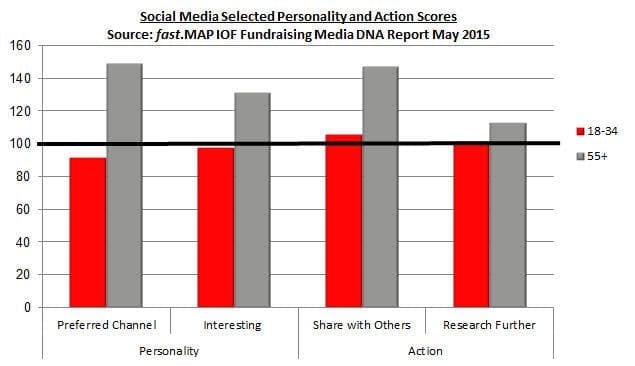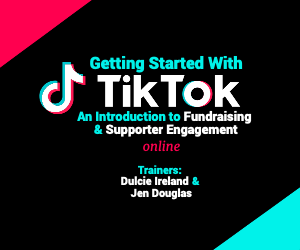Fundraising Media DNA: what’s age got to do with it?
Charities which seek to generate interest from both ends of the age spectrum will be heartened by IOF/fast.MAP Fundraising Media DNA Benchmark study results, which show an overlap of interest within several communication channels.
In the third of our detailed analysis of the Institute of Fundraising/fast.MAP Fundraising Media DNA Benchmark study, we look at how donors respond to fundraising channels by age. You can download your copy of the Fundraising Media DNA report.
Key headlines
• both the 18-34s and over 55s age groups show willingness to engage with charities via DRTV, email and direct mail
• While 18-34s engage with SMS and social media more than other age groups, fundraisers have a tendency to overestimate the volume engaging with them. They also underestimate the volume engaging with more traditional channels, such as DRTV and direct mail.
• Different age groups respond to channels in different ways. For instance, direct mail is welcomed by 18-34s more than other groups, but older groups are more likely to retain it and respond later. Under 35s targeted by direct mail need to be encouraged to respond immediately to generate a return on income
• Over 55s who do follow charities on social media show greater responsiveness and willingness to act, particularly in sharing or researching further
Engagement

Engagement 18-34 vs 55+. Source: fast.MAP/IoF Fundraising Media DNA Report, May 2015
18-34s display above average levels of engagement with two of the top three over 55 communication routes – DRTV and direct mail; and there is a similar overlap of over 55 interest in two of the three 18-34 channels – DRTV and email.
More detailed examination of the data reveals characteristics within various media which are of particular (and sometimes surprising) interest to one group or the other.
It is no surprise that young people engage with the fast, impactful and up-to-the-minute channels they have grown up with, such as DRTV, email and social media (Engagement Index; 18-34, DRTV 122; email 121; social media 120). These channels are achieving high levels of interaction and response from 18-34 year olds.
The over 55s are even more engaged with DRTV and email, but far less interested in social media. They are most likely to favour more traditional media such as direct mail or street fundraising (Engagement Index; 55+, direct mail 163; street fundraisers 165; DRTV 141).
Donors favour direct mail because it can be retained for reference; street fundraising because it facilitates questions and a meaningful conversation about the charity; and DRTV because it can be viewed many times. Over 55s value the opportunities these media offer to allow them to fully consider an appeal or call to action and make an informed decision.
However, fundraisers would be wise to avoid dogged reliance on the obvious age-related communication routes which might lead them to overlook surprising pockets of potential. For example, direct mail is historically referred to as the “Dorothy Donor” channel, but its Fundraising Media DNA shows unexpected interest among other demographic clusters.
Advertisement
Fundraiser expectations
Fundraisers overestimate 18-34s’ engagement with email, SMS and social media, but underestimate their interest in direct mail and DRTV (Engagement Index; direct mail, 18-34, 118; fundraisers expectation, 57).

18-34s’ engagement vs fundraisers’ expectations. Source: fast.MAP/IoF Fundraising Media DNA Report, May 2015
Personality/Attributes
Direct Mail

Direct mail selected personality and action scores. Source: fast.MAP/IoF Fundraising Media DNA Report, May 2015
At a more detailed level, the direct mail data shows 18-34s welcome it more than the over 55s (Welcomed Index; 18-34, 143; 55+, 111), but over 55s are nearly twice as likely to retain it (Retainable Index; 18-34, 115; 55+, 220).
18-34s are more likely to donate/ respond immediately to direct mail campaigns (Donate/ Respond-Immediately Index; 18-34, 94; 55+, 89) and surprisingly, to share the information (Share Index; 18-34, 96; 55+, 77), a fact fundraisers could use to their advantage.
Although, fewer over 55s than 18-34s engage with social media, those who do are much more likely to share the content with others (Share Index; 18-34, 105; 55+, 147) and research further after seeing it (Research Further Index; 18-34, 101, 55+, 131) to better understand and consider the appeal.
Social Media

Social media selected personality and action scores. Source: fast.MAP/IoF Fundraising Media DNA Report, May 2015
The Fundraising Media DNA data highlights various misconceptions about social media. It is seen as a channel for the young, but for those over 55s who do use it, it is a favoured charity contact route (Preferred Channel Index; 18-34, 92; 55+, 149).
The life experience of donors and potential donors affects not only their propensity to give, but also the way they make the giving decision. Young people’s lack of caution and experience leads them to act more impulsively. They respond in real time because they have always lived in a world of instant communication.
Older people’s life experience tends to have taught them to be more careful and considered in their behaviour, more likely to think things through before acting. Fundraisers would be wise to adopt an approach more reliant on patience than pace when communicating with the over 55s.
There is potential for fundraisers to use social media to generate donations from 18-34 and also to communicate with existing social-media savvy, older donors in the run-up or follow-up to traditional media campaigns to boost response.
Findings like these indicate ways in which fundraisers can tweak campaigns and maximise results by comparing the age-related (and other) personality attributes of each channel, to uncover areas which offer potential to reach specific target groups via media which are most likely to generate desired results, such as information-sharing or retention.
What people have to say about difference in ages
“In many ways this research confirms expectations – younger audiences do engage more with social media (Engagement Index: 18-34s, 120 vs. 55+: 62). Even if sometimes fundraisers tend to get a bit excited about the potential more than the current reach, given the level of overestimation occurring here (Engagement Index, 18-34: Estimated 182 vs. Actual 120). There is a difference between the potential of social media as a platform as opposed to what it is at present. Fundraisers should remain excited, but people do have to be strategic in their thinking with the channel.
“Campaigns like No Make Up Selfie take investment in order to get coverage, no campaign is truly vital without an initial boost and it can be hard to justify social media spend when it doesn’t drive a clear, predictable and guaranteed return.
“People of all age groups are also engaging by supporting the personal challenge of a friend. In 2014, 22% of Virgin Money Giving’s traffic was generated from Facebook, Twitter and LinkedIn. That is not caused solely by people in the 18-34 age bracket. The next big trick is to how to continue to move people along the donor journey.”
Alex Heasley, Head of Virgin Money Giving, Virgin Money Giving
“We are all – you, me, each and every one of us – different. It can be easy to make marketing campaigns box us off in some way or another, but that can lead us to make false assumptions and lead to underperforming fundraising campaigns. 18 to 34s are much more likely to engage with social media, but as of January 2014, almost half of 65+ adults were active on social media. That will only have grown since then.
“That’s why insight into what makes any media responsive is so important. There are not channels for the young and old, but it is fascinating to see that people perceive them so differently. Direct mail has cut-through for 18-34s that are often immersed in a digital world (Welcomed Index; 18-34, 143, vs. 55+: 111). Likewise, the 55+ that use social media are far more likely to take an interest in what they see (Interest Index: 55+ 150, vs. 18-34: 125).”
Scott Logie, MD, REaD Group Insight
“The findings from this research show that we should never take ‘accepted wisdom’ at face value. The response and engagement to different communication channels from people in different age groups is complex, and it’s important that fundraisers don’t fall into the trap of making assumptions.
“For example, fundraisers seem to have overestimated how much those who are 18-34 engage with email, SMS and social media, but underestimate their engagement in direct mail and DRTV. Most importantly, these serve as an important reminder that we need to think about the donor as an individual and respond to how they choose to engage with a charity through different channels of communication.”
Daniel Fluskey, Head of Policy and Research, Institute of Fundraising
“For years myself and the team at fast.MAP have run a study called the fast.MAP Marketing-GAP. The report exposes the differences between what marketers understood about customer attitudes and reactions – and what consumers really think. So it was unsurprising to see that fundraisers fall into a similar trap of overestimating the level of engagement and effectiveness of newer channels, while underplaying the value of more traditional media.
“What should be of particular interest to fundraisers is the different reasons that people engage with charities via different channels. An 18-34 year old receiving a piece of direct mail is more likely to welcome it (Engagement Index: 18-34, 143) and are more likely to share the information with others (Share Index; 18-34, 96; 55+, 77). Perhaps the messaging in the communications or call to action should reflect that? On the other hand, 18-34 year-olds are less likely to donate or respond later (Donate/Respond Later Index: 18-34 99 vs. 55+: 115). Fundraisers therefore have to strike in the ‘white heat’ of the moment to maximise the chance of a response. Reminder campaigns also have an important role to play in drawing people to support a particular appeal.”
David Cole, Managing Director, fast.MAP
• Read about the publication of the fast.MAP/IoF Fundraising DNA Benchmark report
• Analysis one: building trust in charities
• Analysis two: DRTV



